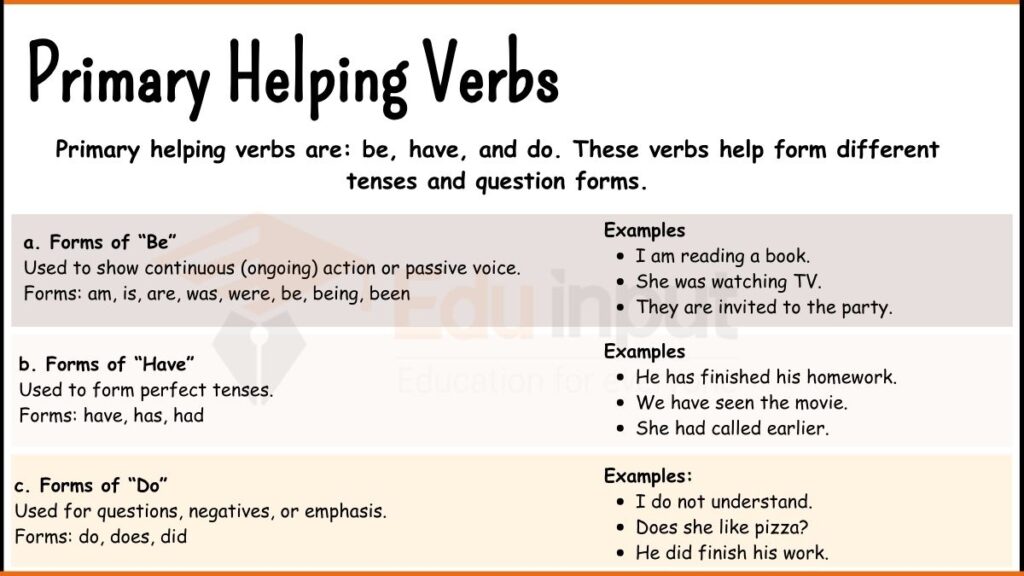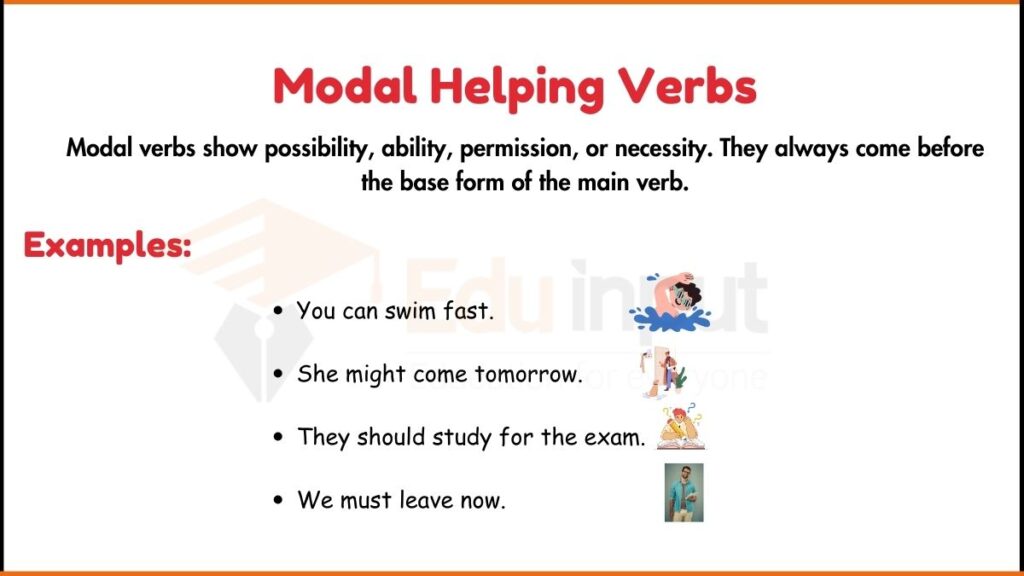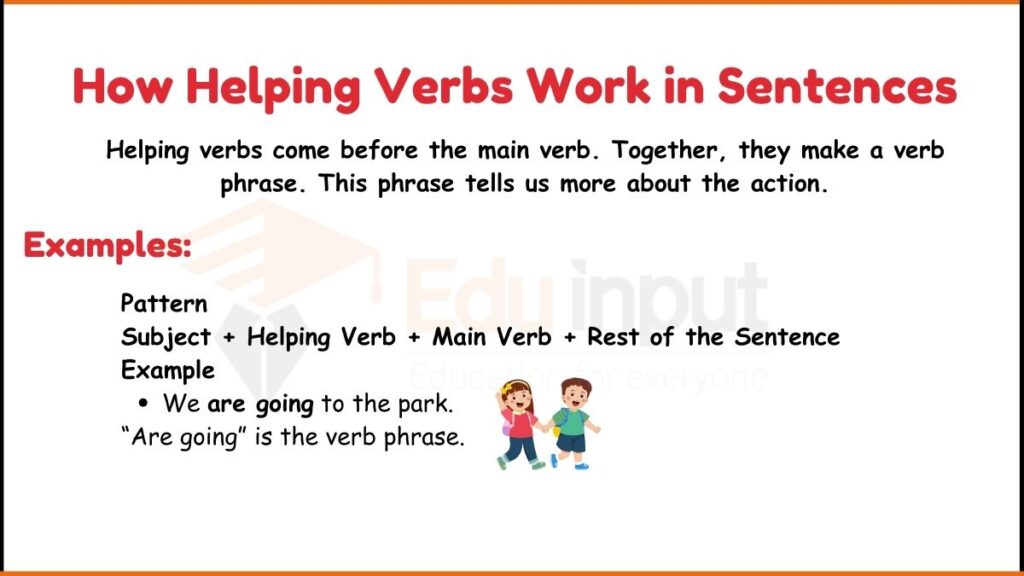Table of Contents
ToggleWhat Is Helping Verb?
A helping verb is also called an auxiliary verb. Unlike action verbs, It does not show action on its own. It works with a main verb to complete the sentence.
Helping verbs help to show time (tense), voice (active or passive), mood, or possibility.

They are very important in forming correct sentences.
Example
- She is eating dinner.
In this sentence, is is the helping verb. Eating is the main verb. Together, they show what she is doing right now.
Types of Helping Verbs
There are two main types of helping verbs:
- Primary Helping Verbs
- Modal Helping Verbs
1. Primary Helping Verbs
Primary helping verbs are: be, have, and do. These verbs help form different tenses and question forms.

a. Forms of “Be”
Used to show continuous (ongoing) action or passive voice.
Forms: am, is, are, was, were, be, being, been
Examples
- I am reading a book.
- She was watching TV.
- They are invited to the party.
b. Forms of “Have”
Used to form perfect tenses.
Forms: have, has, had
Examples:
- He has finished his homework.
- We have seen the movie.
- She had called earlier.
c. Forms of “Do”
Used for questions, negatives, or emphasis.
Forms: do, does, did
Examples:
- I do not understand.
- Does she like pizza?
- He did finish his work.
2. Modal Helping Verbs
Modal verbs show possibility, ability, permission, or necessity. They always come before the base form of the main verb.

Here are some Common Modal Verbs:
- can, could
- will, would
- shall, should
- may, might
- must
Examples
- You can swim fast.
- She might come tomorrow.
- They should study for the exam.
- We must leave now.
How Helping Verbs Work in Sentences
Helping verbs come before the main verb. Together, they make a verb phrase. This phrase tells us more about the action.

Pattern
Subject + Helping Verb + Main Verb + Rest of the Sentence
Example
- We are going to the park.
“Are going” is the verb phrase.
Helping Verbs vs Main Verbs
Helping verbs are not the main action. They assist the main verb. The main verb gives the full meaning.
The helping verb supports the main verb. The main verb shows the actual action or state.
Together, they form a verb phrase.
Example 1
- Sentence: They have gone home.
- “have” = helping verb
- “gone” = main verb
Example 2
- Sentence: She will be studying later.
- “will be” = helping verbs
- “studying” = main verb
Grammar Rules for Helping Verbs (Auxiliary Verbs)
Helping verbs are used with the main verb to form a verb phrase and provide additional meaning. These rules will help you use helping verbs correctly.
Rule 1: Helping Verbs Always Need a Main Verb
Helping verbs cannot stand alone. They must always work with a main verb to complete the action or meaning of the sentence.
Example:
- Correct: She is reading a book.
- Wrong: She is. (This is only correct if followed by a subject complement like “She is a teacher.”)
In short answers, helping verbs can stand alone if the main verb is understood from the context.
Example:
– “Are you coming?”
– “Yes, I am.”
Rule 2: The Helping Verb Comes Before the Main Verb
In English, the helping verb always comes before the main verb in the verb phrase.
Example
- Correct: They have finished their homework.
- Wrong: They finished have their homework.
Never place the helping verb after the main verb.
Rule 3: Modal Helping Verbs Are Followed by the Base Verb
Modal helping verbs (can, could, should, will, etc.) are always followed by the base form of the main verb. The base form of a verb does not have -s, -ed, or -ing endings.
Example
- Correct: She can dance well.
- Wrong: She can danced well.
The base form is the simplest form of the verb: go, eat, run, play.
Rule 4: Use Forms of “Be” for Continuous Tenses
To show that something is happening now or was happening in the past, use a form of “be” with a verb ending in -ing. This creates the continuous tense.
Example
- Correct: I am writing a story.
- Correct: They were playing outside.
- Wrong: They playing were outside.
Forms of “be” include: am, is, are, was, were, be, been, being.
Rule 5: Use Forms of “Have” for Perfect Tenses
Use a form of “have” to show that an action has already happened or was completed before another action. This creates the perfect tense.
Example
- Correct: I have eaten lunch.
- Correct: She had gone home before it rained.
- Wrong: I eaten have lunch.
Past participles usually end in -ed (like “worked”) or are irregular (like “eaten,” “gone,” “spoken”).
Rule 6: Use “Do,” “Does,” or “Did” in Questions and Negatives
In simple present or past tenses, use forms of do to make questions or negative sentences.
- Use do with I, you, we, they.
- Use does with he, she, it.
- Use did for all subjects in the past tense.
Example
- Correct: Do you like ice cream?
- Correct: I do not like it.
- Correct: Did she call you?
- Wrong: She not like ice cream.
After do/does/did, use the base form of the verb.
Rule 7: Helping Verbs Are Used in the Passive Voice
In the passive voice, the subject receives the action instead of doing it. To form the passive voice, use a form of “be” + the past participle of the main verb.
Example
- Correct: The song was sung by the choir.
- Correct: The homework is done.
- Wrong: The song sung by the choir.
Active: The teacher wrote the letter.
Passive: The letter was written by the teacher.
Practice Exercises for Helping Verbs
Here are some practice exercises with answer keys to help you understand helping verbs.
Practice Exercise 1: Identify the Helping Verbs
Read the sentences below. Underline or highlight the helping verbs in each sentence.
- She has been working all day.
- They are planning a trip to the beach.
- I will be going to the store later.
- We had finished our homework before the bell rang.
- The dog has been barking all night.
Practice Exercise 2: Choose the Correct Helping Verb
Select the correct helping verb to complete each sentence.
- She ___ running late for the meeting.
- a) is
- b) are
- c) was
- They ___ eaten lunch before the movie.
- a) has
- b) have
- c) did
- I ___ read the book by tomorrow.
- a) will
- b) am
- c) have
- He ___ studied for the test last night.
- a) had
- b) does
- c) will
- We ___ going to the park when it started to rain.
- a) were
- b) did
- c) is
Practice Exercise 3: Convert Active to Passive Voice
Rewrite the following active sentences into passive voice. Remember to use the correct form of the helping verb “be” and the past participle of the main verb.
- The teacher explains the lesson.
- The chef cooked a delicious meal.
- The company will launch a new product next month.
- She has finished her project.
- They were cleaning the house when I arrived.
Answer Key:
Exercise 1:
- has been
- are
- will be
- had
- has been
Exercise 2:
- a) is
- b) have
- a) will
- a) had
- a) were
Exercise 3:
- The lesson is explained by the teacher.
- A delicious meal was cooked by the chef.
- A new product will be launched by the company next month.
- Her project has been finished.
- The house was being cleaned when I arrived.


